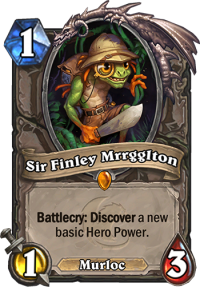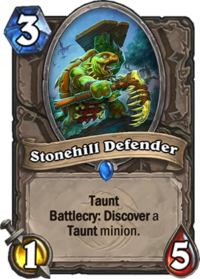In the last four years of Hearthstone, over 20 card mechanics made it into the game. Most of Hearthstone “keywords”, as mechanics are called in Blizzard’s card game, have been in the game since its release. They form the backbone of every strategic card game, and every single one of them aims to provide just the right amount of replayability, effectiveness and value to be played.
Team 5 has been very conservative with adding new keywords to the game, just because it is so hard to hit that “golden spot”, but there is one mechanic in particular which just does everything a Hearthstone player would ever want: Discover. Why is Discover a fan favorite, and how does the keyword still create so much fun when played, even almost three years after its addition to the game?
A Slow Beginning

The Discover keyword got introduced with Hearthstone’s third adventure, The League of Explorers. At first, the new mechanic looked very simple and easy to use: Whenever a Discover card is played, the player gets to choose between three randomly generated cards.
Back then, nobody expected the Discover mechanic to have such a big influence in terms of gameplay; not last because Team 5 took the slow road with it. Only nine cards in total were printed with the new keyword, and some of them up to this day still feel very underwhelming. However, almost all cards with a semi-decent body and/or mana cost like Raven Idol, Dark Peddler or murloc all-star Sir Finley Mrrgglton were used in the majority of archetypes after the release of LoE.
The reason behind the decision to only publish a few cards may not be obvious at first, but back in 2015, card draw and card generation were much more powerful in the bigger picture compared to today’s meta game. Not only would too many Discover cards have devalued other card draw cards drastically; they would have also increased the overall power level of decks by a mile compared to any other set in the past. Thankfully, Blizzard decided to follow their design principles to guarantee that the great idea behind Discover still kept overall balance in place.
Choice Translates into Power
Almost three years and many hundred cards later, we now have a whooping 37 cards with the Discover keyword on them, and that proves that the mechanic not only fits Hearthstone’s design space but also feels great to players.
The reason behind this great feeling when playing a Discover card comes down to simple psychology: Choice conveys a sense of power. The decision to choose between three cards creates three different scenarios: The first scenario shows two bad cards and one great card. The decision is easy, and your obviously correct decision adds that great card to your hand, so you did everything right!
The second scenario shows three very good cards. The decision you have to make is not an easy one, but in the end you evaluated it to your best ability and took the card of choice. And you did not only make your tough but correct choice, you got a great card with it as well!
Last but not least is the scenario where three terrible cards are shown. The thought process is the same as in the second situation, with the difference that you still feel okay because you did your best to choose the best-worst card out of the three!
Long story short, playing a Discover card is almost always a win-win situation. To make the “correct” decision always feels right and creates a positive connotation, and Discover achieves that regularly on a very basic and accessible level.
The Class Card Twist

Despite the fact that Discover operates on a very basic level, some aspects of it show that the mechanic has gone through many iterations before, and that is why it has become the balanced keyword we now adore.
The fact that class cards have four times the weight in probability of getting shown by a Discover card adds class-based depth and a feeling of “class affiliation”. The ability to dynamically add cards to your deck that you normally would not be able to play in the first place not only redefines existing design space but also just feels incredible as a player. Stonehill Defender may be the prime example in this case: Archetypes like Odd Paladin are literally not allowed to play the most powerful class cards, but Discover cards like Stonehill Defender opens up opportunities to draw cards like Sunkeeper Tarim or Tirion Fordring.
Balance is King
After slowly introducing the Discover mechanic to players, Team 5 now knows what it’s worth in terms of value and power level. That seems to make balancing additional spell effects or minion bodies around most Discover cards very easy. That is one of the main reasons why those cards are very well balanced compared to other cards with a high power level. Not a single card with the Discover keyword has been nerfed yet, and still a lot of them have been played very frequently across all archetypes.
Keeping balance in this case is not only key; it is the last puzzle piece to what many call the perfect mechanic in Hearthstone.
Rewarding decision-making in combination with the fact that your opponent doesn’t feel as bad when you add a good card to your deck turns the Discover keyword into a dream that came true for every Hearthstone player and designer alike. Drawing a card depending on the current situation can turn around the whole match once in a while, but most of the times it just fills out your curve on one of your turns, and that, again, is perfectly fine and balanced.
One can only hope that more keywords like Discover get added to Hearthstone. However, looking at the development of the mechanic, it really seems that less is more in this case. And thanks to its depth in terms of fun and rewarding gameplay, Team 5 can always add more Discover cards and do nothing wrong! Right?


Discover is indeed the best mechanic in Hearthstone. I always say that RNG done right is what makes a game like Hearthstone fun, and what real card games could never have. This mechanic does it: the choices are random, but you still get to pick, so there’s skill involved. In general good mechanics keep coming back into new expansions. Lifesteal, Poisonous, Discover, and recently Rush, are all great mechanics, and we will keep seeing them. Charge I believe we will be seeing less and less, although staples like Leeroy will always be there (and I think that’s OK, as long as we don’t have old Warsong Commander around).
This is not an Ode.
Just saying :p
Most discover cards are balanced…except Primordial Glyph.
Primordial Glyph is balanced, it’s just that it can be extremely good or extremely bad. I’ve played a ton of Aluneth Aggro Mage and it was a horrible feeling to not get at least a burn damage spell, which happens about 20% of the time. In Wild Primordial Glyph is much worse since the pool is diluted with horrible spells.
It also helps matchups from feeling too stale, since it gives you a variety of cards to play (and play against!) that weren’t otherwise in your deck… but in a much more reliable and satisfying way than “add a random ___ to your hand” sorts of effects.
Also handy for the new player experience, who don’t have a big card pool to play around with otherwise. How many budget Paladin decks included Stonehill Defender, knowing it was practically as good as having a Tirion or Tarim?